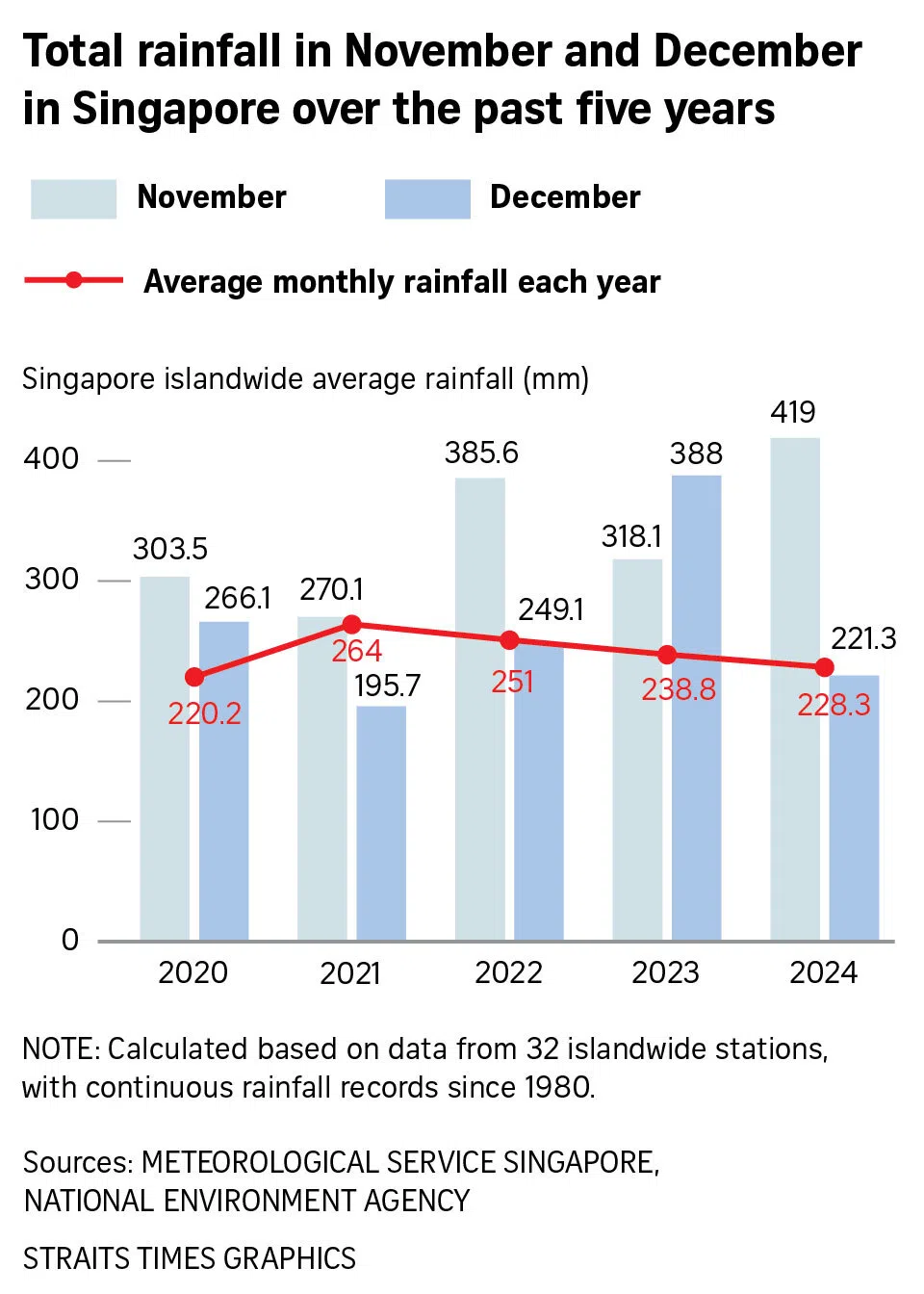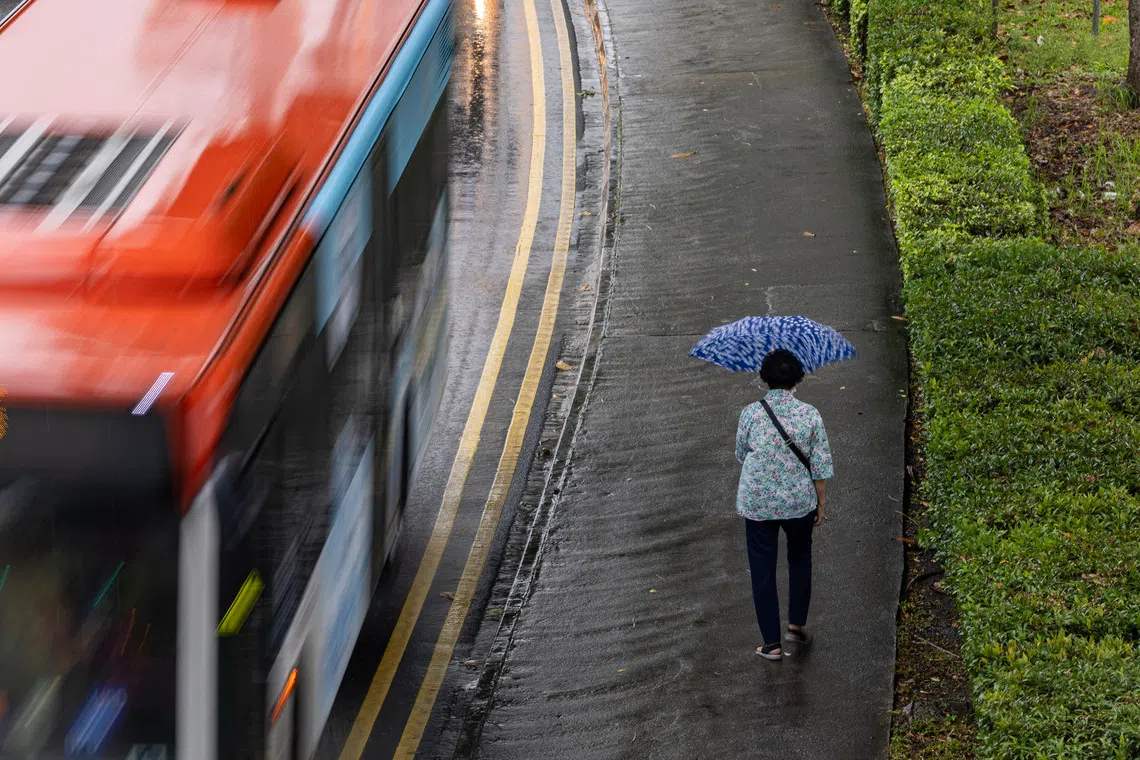SINGAPORE – More than 600 water level sensors will be installed islandwide by 2028 to improve flood monitoring in Singapore, national water agency PUB said on Nov 17.
Other measures PUB has in the works to boost flash flood preparedness in the country include integrating flood alerts on Google maps, and using mobile phone signals to better predict intense rainfall.
PUB made these announcements as it launched its annual flood awareness campaign ahead of the upcoming wet season. The first such campaign was rolled out in late 2024.
The year-end rainy season is brought about by the wet phase of the north-east monsoon, when winds blow from the cool Northern Hemisphere towards the equator.
The Meteorological Service Singapore (MSS) said in its
fortnightly weather outlook on Nov 17
that the monsoon is expected to set in around end-November. The total rainfall for the upcoming fortnight is forecast to be above average over most parts of the island.
PUB said that the additional 650 water level sensors will be installed in drains and canals by end-2028. This will enable the agency to hasten the deployment of quick response vehicles when a flash flood in a particular road is expected. These yellow vans help to divert traffic from flooded lanes, and officers will install portable flood barriers.
The additional sensors will add to the more than 1,000 existing sensors and over 500 closed circuit television (CCTV) cameras, rain gauges and weather radars. Such a sensor network will ensure that the water levels of every kilometre of the country’s major waterways and canals will be closely watched and accounted for.
“Enhanced flood monitoring capabilities also help us to issue prompt alerts to the public so that they can better prepare and respond effectively in the event of floods,” said PUB.
The agency is also working with Google to integrate flood alerts on Google Maps, allowing motorists and commuters to have access to flood information to plan their routes during rainy days.
PUB said it is also collaborating with Starhub and water management solutions provider Hydroinformatics Institute on a project using cellular signals to predict the intensity of rainfall more accurately. This project is targeted to be completed by the end of 2025, with potential to be implemented islandwide then.
This followsa 2022 pilot that showed that when it rains, falling water droplets
can sometimes interfere with mobile signals being sent islandwide.
These interferences can be tapped to identify parts of the island that will have intense rainfall, and potentially, floods.
PUB’s campaign theme of “nobody needs to be the wet one out” promotes community preparedness by highlighting actions that pedestrians, motorists, as well as home and building owners can take to protect themselves and their properties from floods.
“In Singapore, sudden and intense rainfall can temporarily overwhelm our drains and lead to flash floods. Climate change will exacerbate this by contributing to more extreme weather,” said the agency.
Previously, PUB worked with ride-hailing giant Grab’s mobile app and the Land Transport Authority’s Electronic Road Pricing on-board units to disseminate flood alerts.
The north-east monsoon period will also usually see one to three episodes of monsoon surges, which results in non-stop rain and cooler temperatures over a few days, as was the case earlier this year.
The first surge episode in early January led to a
nearly three-hour flood in Jalan Seaview in Mountbatten.
Preparing the community for floods is central to PUB’s annual campaign. The East Coast and Bukit Timah areas are among the flood-prone areas in Singapore.
On Nov 8, 25 residents and community leaders gathered at Siglap Community Club in the East Coast area to brainstorm ideas to be more prepared for floods.

PUB also recently held flood preparedness drills at a distribution substation on Enterprise Road and the Ba’alwie Mosque in Bukit Timah, both of which experienced flash floods in recent years. Work is also being done to create flood response protocols for schools in Bukit Timah.
There is a possibility that the wetter season may extend beyond January 2026, as two rain-bearing phenomena are
accompanying the north-east monsoon
, The Straits Times reported on Nov 16.
They are La Nina and the negative phase of the Indian Ocean Dipole (IOD). Both climate phenomena tend to result in higher rainfall over Singapore, owing to changes in atmospheric pressure and sea surface temperatures across the Pacific and Indian oceans.
MSS noted on its website that Singapore is on “La Nina watch”, which it says is expected to persist until at least the end of 2025.
The Met Service told The Straits Times earlier that La Nina events usually have no noticeable effects on Singapore’s total rainfall during the December to January period.
Instead, they increase the likelihood of wetter conditions during the dry phase of the north-east monsoon season between February and March.

